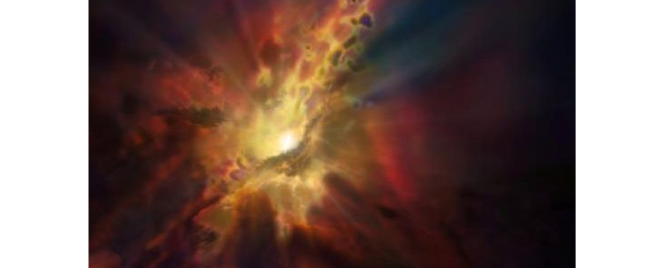ASTRONOMERS GET FIRST LOOK OF 'SUPERMASSIVE' BLACK HOLE GORGING ON GAS.
Gas clouds plunging toward the supermassive black hole at its centre of a galaxy CREDIT:STR/AFP/GETTY IMAGE
Astronomers in Chile said on Wednesday they had caught the first-ever glimpse of a "supermassive" black hole preparing to gorge itself on gas clouds about a billion light years from Earth.
Using the ALMA telescope in the Atacama desert, the international team spotted three clouds streaming towards a black hole at speeds of up to 800,000 miles per hour.
Composed mainly of carbon monoxide, the clouds were "only" 300 light years from the huge hole, "essentially teetering on the edge of being devoured, in astronomical terms," the European Southern Observatory said in a statement.

Deep in the heart of the Abell 2597 Brightest Cluster Galaxy, astronomers see a small cluster of giant gas clouds raining in on the central black hole CREDIT: STR/AFP/GETTY IMAGES
The microwave-spectrum observation provides the first direct evidence for the theory that black holes feed on clouds of gas.
The microwave-spectrum observation provides the first direct evidence for the theory that black holes feed on clouds of gas.
"It was magical being able to see evidence of these clouds accreting onto the supermassive black hole," said Timothy Davis of Cardiff University, who took part in the research. "This is telling us more about what they (supermassive black holes) like to eat and how they evolved," he told AFP.
The researchers cannot observe the black hole directly, inferring its presence from the motion of objects around it.
The observation was an accidental one, the teams were trying to measure how many stars are born in the galaxy when they spotted the clouds.
"We use the black hole as a backlight," said Mr Davis. "So, the black hole itself obviously emits no radiation but as stuff falls into the black hole that stuff is heated to very high temperatures and that material emits a lot of light.
"So what we see in this case is the shadow of the clouds as they fall into what's the black hole... they're between us and the black hole so they blank out some of this light."
Black holes are very dense regions in spacetime with a gravitational force so strong that even light cannot escape it - making them invisible.
for blue colourFollow us on Twitter - @akatechsolution / @smartdevicess
Leave a Comment
Let Millions of People know about your Product(s) / Service(s)
Target a Specific Audience on different News Categories
Our Partners
"Making the simple complicated is commonplace; making the complicated simple, awesomely simple, that's creativity"
- Charles Mingus






















































